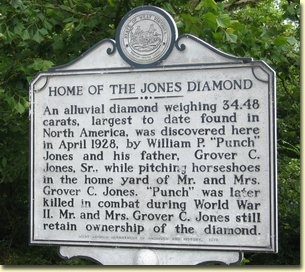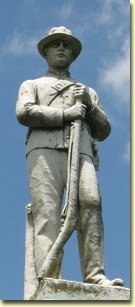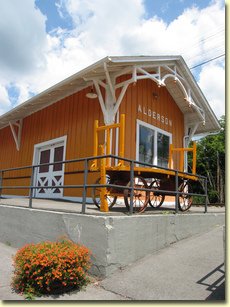About Monroe County
A Brief Historical Sketch
 Secluded in the Allegheny Highlands, present-day Monroe County
remained a land unseen for several generations of early Virginia
colonists. The first settlers arrived around 1760, beginning a
30-year period of frontier conflict. Formation of Monroe as a
separate County, separated from Greenbrier, came in 1799. The new
County was named for James Monroe, who was later to be governor of
Virginia and President of the United States.
Secluded in the Allegheny Highlands, present-day Monroe County
remained a land unseen for several generations of early Virginia
colonists. The first settlers arrived around 1760, beginning a
30-year period of frontier conflict. Formation of Monroe as a
separate County, separated from Greenbrier, came in 1799. The new
County was named for James Monroe, who was later to be governor of
Virginia and President of the United States.
Monroe's economic basis has always been farming and timber harvesting. Beginning around 1790, two additional activities were important for about 70 years. It was the age of water power, and streams such as Indian Creek and The Second Creek supported more than two dozen water-powered mills. During the same period, the area's mineral springs became major summer resorts, catering to Southerners seeking relief from lowland summer heat.

Monroe County supported the Confederate cause during the War Between the States. When the Federal side carved the new State of West Virginia from Virginia in 1863, it included Monroe County, a designation resisted by residents until the 1865 surrender.
After the War, with the South's economy and social order devastated, the old resorts faded away. New railroads came nearby, but bypassed Monroe County except at its more accessible edges. Steam power and newer forms of energy overshadowed water power. Lacking suitable coal deposits, Monroe County lies outside the mining area which encompasses most of West Virginia. For these reasons, "Old Monroe" still relies largely on agriculture and retains its pastoral character. In recent times, its tranquil landscape has attracted a number of artisans, retirees, and knowledge workers.
Historic Districts and Features
 This is an abridged list, not including private homes. The West
Virginia Division of Culture and History maintains a
complete
list, including links to detailed information.
This is an abridged list, not including private homes. The West
Virginia Division of Culture and History maintains a
complete
list, including links to detailed information.
- Historic Districts
- Alderson
- Pickaway
- Salt Sulphur Springs
- Sweet Springs (Lynnside)
- The Second Creek Watershed (proposed)
- Union
- Covered Bridges
- Indian Creek Covered Bridge (Rte. 219 south of Union)
- Laurel Creek Covered Bridge (between Greenville and Lillydale)
- Other Structures (Excluding private homes; the
buildings listed here are accessible to the public on at least a
part-time basis.)
- Cook's Old Mill (Greenville)
- Reed's Mill (Second Creek; usually open on Saturdays)
- Rehoboth Church and Museum (Rte. 3 east of Union; open Friday, Saturday, and Sunday afternoons April through October; other times by appointment - call 304-772-3518)
- Archaeology at Cook's Fort
This video podcast documents archaeology at Cook's Fort near Greenville in June of 2021. Cook's Fort was an important militia fort built on the land of Valentine Cook in 1774, during Lord Dunmore's War. It was important as a base for militia and a refuge for settlers during this war and the American Revolutionary War. The archaeology provides valuable information about the structure of the fort. Artifacts and animal bones from food refuse provide insights into life in the fort. Many local persons volunteered during the excavations, including students from James Monroe High School. The archaeology was directed by Dr. W. Stephen McBride, Dr. Kim Arbogast McBride and J. David McBride, of McBride Preservation Services. It was funded by a grant from the West Virginia Division of Culture and History to the Summers County Historical Landmarks Commission. The grant is administered by Steve Trail, with support from Fred Ziegler of the Monroe County Historic Landmarks Commission and Monroe County Historical Society.
- Byways (more information)
- Farm Heritage Road
- Mountain's Shadow Trail
- Wolf Creek
- Vehicle - The Monroe County Omnibus
Additional Information
The official Travel Monroe County site
The West Virginia Division of Highways has very detailed downloadable maps.
A book by George Hall (moccasinrangers1861@yahoo.com), "Civilian War in West Virginia, the Moccasin Rangers", focuses on Civil War action surrounding Nicholas County and includes episodes which occurred in Monroe County. A video of his presentation about it is posted on YouTube by the Division of Culture and History.
The Monroe County Clerk and Recorder has maintained records since 1799. Records 1778-1799 are held in Monroe's parent, Greenbrier County.
Monroe County native Andrew S. Rowan became a war hero in the famed "Message to Garcia" incident of the Spanish-American War. See story
The 60th Virginia Infantry Regiment enlisted many Monroe County soldiers on the Confederate side. The website contains much information on the regiment and a current campaign to save a fragile specimen of the unit's flag.
